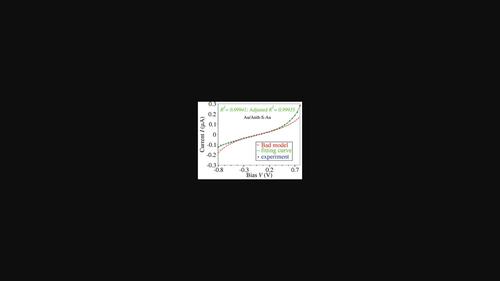当前位置:
X-MOL 学术
›
Adv. Theory Simul.
›
论文详情
Our official English website, www.x-mol.net, welcomes your
feedback! (Note: you will need to create a separate account there.)
Are Asymmetric SAM-Induced Work Function Modifications Relevant for Real Molecular Rectifiers?
Advanced Theory and Simulations ( IF 2.9 ) Pub Date : 2022-04-05 , DOI: 10.1002/adts.202200077 Ioan Bâldea 1
Advanced Theory and Simulations ( IF 2.9 ) Pub Date : 2022-04-05 , DOI: 10.1002/adts.202200077 Ioan Bâldea 1
Affiliation

|
Due to the fabrication architecture employed—flat s(ubstrate) versus sharp t(ip), chemisorption versus physisorption, etc–, self assembled monolayers (SAMs) break the forward-backward invariance even in case of homometal molecular junctions; they induce changes in electrodes' work function different from each other (ΔΦs≠ΔΦt ). Because differences ΔΦs>ΔΦt translate into internal (Volta) electric fields often exceeding those created by the highest applied biases that real junctions can withstand, one may expect effects relevant for current rectification (RR). Here, they theoretically analyze asymmetric raw I-V data of benchmark junctions. Notwithstanding the large values |ΔΦs−ΔΦt|≈1 eV, they found that the impact on rectification is completely negligible. So, the present theoretical results conveys a word of caution: not any effect that strongly breaks the inversion symmetry necessarily leads to current rectification. While their analysis indicates that per se unequal SAM-induced ΔΦ 's can hardly affect RR-values in general, it does not rule out an indirect effect for junctions where ΔΦ 's affect the charge transfer between the metal layer at interface and the bulk. From this perspective, using interposed narrow-band metal adlayers may be an appealing route toward improving rectification via interface engineering.
中文翻译:

非对称 SAM 诱导的功函数修改与实际分子整流器相关吗?
由于所采用的制造结构——平坦的 s(基板)与尖锐的t(ip)、化学吸附与物理吸附等——即使在同金属分子结的情况下,自组装单分子层(SAM)也打破了前后不变性;它们引起电极功函数的变化彼此不同(ΔΦs≠ ΔΦ吨 )。因为差异ΔΦs> ΔΦ吨 转化为内部(伏特)电场,通常超过实际结可以承受的最高施加偏置所产生的电场,人们可能会预期与电流整流(RR)相关的影响。在这里,他们从理论上分析了基准结的不对称原始I - V数据。尽管值很大| ΔΦs- ΔΦ吨| ≈ 1 eV,他们发现对整改的影响完全可以忽略不计。因此,目前的理论结果传达了一个警告:并非任何强烈破坏反演对称性的效应都必然导致电流整流。虽然他们的分析表明,本身不平等的 SAM 诱导ΔΦ _ 's 通常几乎不会影响 RR 值,但不排除对以下路口的间接影响ΔΦ _ 影响界面处金属层与体之间的电荷转移。从这个角度来看,使用插入的窄带金属层可能是通过界面工程改进整流的一条有吸引力的途径。
更新日期:2022-04-05
中文翻译:

非对称 SAM 诱导的功函数修改与实际分子整流器相关吗?
由于所采用的制造结构——平坦的 s(基板)与尖锐的t(ip)、化学吸附与物理吸附等——即使在同金属分子结的情况下,自组装单分子层(SAM)也打破了前后不变性;它们引起电极功函数的变化彼此不同(











































 京公网安备 11010802027423号
京公网安备 11010802027423号